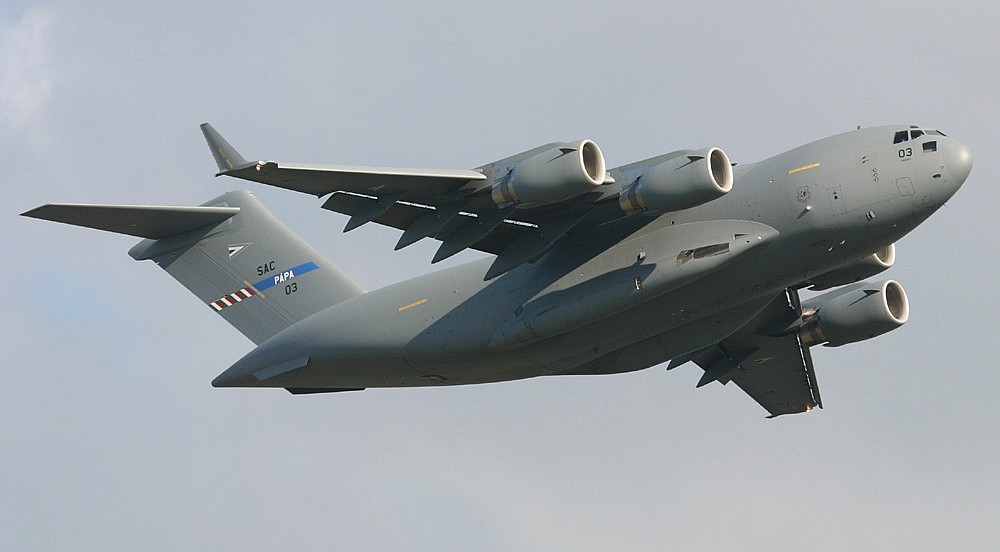45 de tone de echipament medical au ajuns din Coreea pe Aeroportul Militar Otopeni.
Transportul a fost asigurat cu o aeronavă C-17 Globemaster III, în cadrul cotei de ore de zbor alocate României, ca stat membru al Unității Multinaționale de Transport Strategic.
Unul dintre comandanții echipajelor care operează aeronava pe timpul acestei misiuni este locotenent-comandorul George Crăciun, pilot din Forțele Aeriene Române, detașat în cadrul Unității Multinaționale de Transport Strategic.
Ministerul Apărării Naționale a solicitat saptamana trecuta Unității Multinaționale de Transport Strategic care operează de pe Baza Aeriană Papa din Ungaria, desfășurarea unei misiuni aeriene de urgență, pentru transportul a aproximativ 45 de tone de echipament medical de la Seul la București.
Echipamentele, 100.000 de combinezoane de protecție, au fost achiziționate de statul român prin Oficiul Național de Achiziții Centralizate, în cadrul eforturilor de combatere a efectelor pandemiei de COVID-19 în țara noastră.
NATO Airlift Management Programme
The NAM Programme Office is an integral part of the NATO Support and Procurement Agency (NSPA) and executes acquisition and sustainment on behalf of the member nations of the Strategic Airlift Capability (SAC). It manages the full life-cycle of the Boeing Globemaster III large transport aircraft. Mission execution is the sole responsibility of the operational arm of the SAC, the multinational military unit, the Heavy Airlift Wing (HAW).
The NAM Programme is split in two divisions:
- The Weapon Systems Management division, responsible for the life-cycle management of the C-17 weapon system and other aeronautical products.
- The Wing Support Management division, responsible for provision of Direct Support to the HAW and life-cycle management of SAC infrastructure.
The NAM Programme receives support from several NSPA Support Functions. Managers in these functional area, like Finance, Procurement, Information Technology and Security, are collocated with the Programme, execute both functional and operational tasks.
At the core of the NAM Programme’s ground breaking support to the C-17 weapon system is their membership in the C-17 ‘Virtual Fleet’. ‘Virtual Fleet’ refers to the Boeing Globemaster III Integrated Sustainment Program (GISP), a business model for C-17 spare parts and maintenance support. The NAM Programme Office sources the majority of the technical, logistics and training support to the SAC C-17 fleet from the United States Government through its Foreign Military Sales (FMS) programs. Maintenance responsibilities are contracted through the GISP to Boeing.
The GISP provides the SAC the leverage obtained from the larger United States Air Force organization and from cooperation with other partners. Members also include Australia, Britain, Canada, Kuwait, India, Qatar, United Arab Emirates and the USA. The Virtual Fleet is based on intensive cooperation between members and provides an ultra-efficient, low risk solution that enables the NAM Programme to sustain more than 90% aircraft availability to the HAW. One common technical configuration of the aircraft allows parts and personnel to be exchanged between aircraft of individual countries and of NAM Programme, which creates one worldwide operating fleet of C-17’s.
A main project managed by the NAM Programme Office is the SAC Infrastructure Development Project. The new infrastructures will support flight operations and consist of a C-17 size maintenance hangar, maintenance facilities and office buildings. The possibility to execute maintenance in a hangar at Pápa Air Base will translate into reduced maintenance costs and more aircraft availability for the 12 SAC participating nations. Also a large number of IT-related projects are on-going, like the Mission Monitoring and Scheduling System and the Electronic Document Management System. These new systems will in some of the cases require re-arranging the organization and its function.
The NAM Programme Office has achieved a world class Mission Capable rate of approximately 94 % over the past years and managed to keep the annual operating costs below the target of 133 million USD at 2007 prices.








